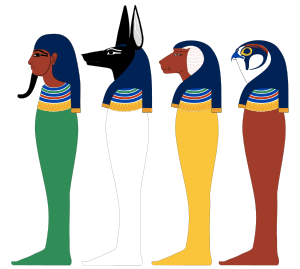
Back Vier seuns van Horus Afrikaans أولاد حورس Arabic اولاد حورس ARZ Bugale Horus Breton Horusovi sinovi BS Quatre fills d'Horus Catalan Synové Horovi Czech Horus' sønner Danish Horussöhne German Τέσσερεις γιοι του Ώρου Greek

The four sons of Horus were a group of four deities in ancient Egyptian religion who were believed to protect deceased people in the afterlife. Beginning in the First Intermediate Period of Egyptian history (c. 2181–2055 BC), Imsety, Hapy, Duamutef, and Qebehsenuef were especially connected with the four canopic jars that housed the internal organs that were removed from the body of the deceased during the process of mummification. Most commonly, Imsety protected the liver, Hapy the lungs, Duamutef the stomach, and Qebehsenuef the intestines, but this pattern often varied. The canopic jars were given lids that represented the heads of the sons of Horus. Although they were originally portrayed as humans, in the latter part of the New Kingdom (c. 1550–1070 BC), they took on their most distinctive iconography, in which Imsety is portrayed as a human, Hapy as a baboon, Duamutef as a jackal, and Qebehsenuef as a falcon. The four sons were also linked with stars in the sky, with regions of Egypt, and with the cardinal directions.
The worship of the sons of Horus was almost entirely restricted to the funerary sphere. They were first mentioned late in the Old Kingdom (c. 2686–2181 BC) in the Pyramid Texts and continued to be invoked in funerary texts throughout ancient Egyptian history. Their connection with the canopic jars was established in the First Intermediate Period, and afterward they became ubiquitous in the decoration of canopic chests, coffins, and sarcophagi. Although they were increasingly closely associated with the internal organs, they continued to appear in burial equipment even after the use of canopic jars was abandoned in the Ptolemaic Period (303–30 BC), disappearing only in the fourth century AD with the extinction of the ancient Egyptian funerary tradition.